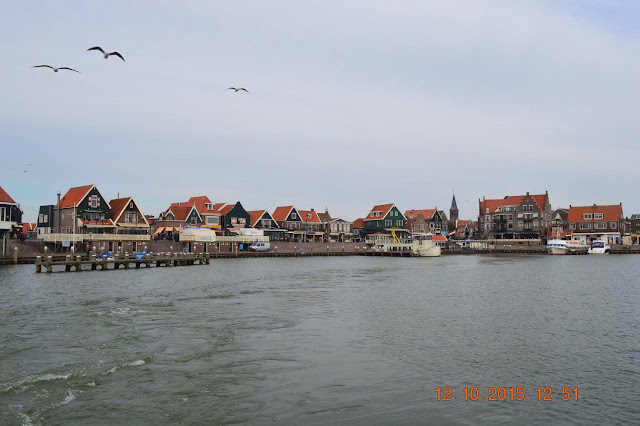Date: 12th October 2015
It was about lunch time when we were done with a little exploration inside the Cheese Factory. The tour guide then gathered us all and lead us to where we can have lunch on our own. The winds blow was no joke when we were at Volendam harbour, hence, Anne and I chose for an indoor lunch. I wanted to grab a food outlet outside but thinking of a warmer environment inside the nice cafe that we finally opted has stopped me from persuading Anne for a set lunch available at a much cheaper price outside.
 |
| A small fishing village harbor of Volendam |
Volendam is a town in North Holland in the Netherlands, in the
municipality of Edam-Volendam. The town has more than 22,000 inhabitants. Originally, Volendam was the
location of the harbor of the nearby Edam, which was situated at the mouth of
the IJ bay. In 1357, the inhabitants of Edam dug a shorter canal to the
Zuiderzee with its own separate harbor. As a result, it removed the need for the original
harbor, which was then dammed and used for land reclamation. From here onward, I spice up the reading about Volendam with photos that I snapped inside the beautiful decorated cafe.
 |
| A cool decor inside the cafe |
Netherland on the other hand is a country of reclamation and geographically is a very low and flat country, with about 26% of its area and 21% of its
population located below sea level. Only about 50% of its land
exceeding one metre above sea level. The country is for the most part is flat,
with the exception of foothills in the far southeast, up to a height of no more
than 321 metres, and some low hill ranges in the central parts. Most of the
areas below sea level are man-made, caused by peat extraction or achieved
through land reclamation. Since the late 16th century, large polder areas are
preserved through elaborate drainage systems that include dikes, canals and
pumping stations. Nearly 17% of the country's land area is reclaimed from the
sea and from lakes.


Farmers and local
fishermen settled and forming the new community of Vollendam. It literally meant something like 'Filled dam'. In the early part of the 20th
century it became something of an artists' retreat, with both Picasso (Spanish painter) and
Renoir (French painter) spending time here. The majority of the population belongs to the Roman
Catholic Church, which is deeply connected to the village culture.
Historically, many missionaries and bishops grew up in Volendam. Today there is
the chapel of Our Lady of the Water, which is located in a village park. Alas, we did not get to see that as everyone is adjourned for lunch.
 |
| A clean toilet and it's sign that is so attractive to see |
Volendam is a popular tourist
attraction in the Netherlands, well known for its old fishing boats and the
traditional clothing still worn by some residents. The women's costume of
Volendam, with its high, pointed bonnet, is one of the most recognizable of the
Dutch traditional costumes, and is often featured on tourist postcards and
posters (although there are believed to be fewer than 50 women now wearing the
costume as part of their daily lives, most of them elderly). There is a regular
ferry connection to Marken, a peninsula close by. Volendam also features a
small museum about its history and clothing style, and visitors can have their
pictures taken in traditional Dutch costumes. But we did not get to see those traditional costume due to time limitation. Below are the seafood that we indulged that day.
 |
| The way Anne rated the cafe |
After lunch, while waiting for others to gather, we decided to try the famous "herring", a local fish dishes that we vowed to try. Apparently, we found the same types of dish in the Scandinavian country too. This region is very safe to find Muslim food, I mean to get a fish dish which is halal for us to eat.
Herring
has been a staple food source since at least 3000 B.C. There are numerous ways
the fish is served and many regional recipes are either eaten raw, fermented,
pickled, or cured by other techniques, such as being smoked as kippers. The
lady that serves us that day informed that the Dutch likes their herring in
fermented (the 1 that we tasted). Herring are very high in the long-chain
Omega-3 fatty acids EPA and DHA. They are a source of vitamin D.
 |
| Fermented herring |
 |
| Smoked type |
Do take note that water pollution
influences the amount of herring that may be safely consumed. For example,
large Baltic herring slightly exceeds recommended limits with respect to PCB
and dioxin, although some sources point out that the cancer-reducing effect of
omega-3 fatty acids is statistically stronger than the cancer-causing effect of
PCBs and dioxins. The contaminant levels depend on the age of the fish which
can be inferred from their size. Baltic herrings larger than 17 cm may be eaten
twice a month, while herrings smaller than 17 cm can be eaten freely. Mercury
in fish also influences the amount of fish that women who are pregnant or
planning to be pregnant within the next one or two years may safely eat.


It was time to board a ship to Marken where the Tickets & Tours has arranged in the itinerary for us to ride in a Marken Express to the reach Marken Island. The rest of the photos that I'm sharing herewith are from the short and memorable ride. Do give it a try, I mean taking Marken Express. The view and a group of Seagulls following us that day was indeed priceless.



















No comments:
Post a Comment